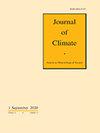Exploring the asymmetries of pan-tropical connections from the tropical Indian to the Pacific basin
IF 4.8
2区 地球科学
Q1 METEOROLOGY & ATMOSPHERIC SCIENCES
引用次数: 1
Abstract
Recent analysis of pan-tropical interactions suggests that post-1980, the tropical Indian Ocean’s (TIO) influence on the tropical Pacific Ocean (TPO) appears to have subdued, while the tropical Atlantic Ocean’s (TAO) influence has become more pronounced. The present study explores whether we can identify and dynamically explain any asymmetries in the pan-tropical connection between the TIO and TPO SSTs in an attempt to explain the recently reported weakening of the TIO influence. To this end, we carry out two idealised atmosphere-only experiments using the ACCESS atmospheric general circulation model where the sign of the decadal TIO SST signal is varied – presenting warm and cool TIO scenarios. We find a relatively strong asymmetric response of TPO precipitation to TIO SST anomalies, where average TPO precipitation shows a strong increase in response to TIO cooling, but a weaker decrease in response to TIO warming. The asymmetry is hypothesized to result from differences in the depth of latent heating over the TIO which ultimately affects the depth of the remote response over the TPO. Asymmetries also occur in the spatial pattern of the changes in precipitation and surface winds. In the fully coupled system, these asymmetries would be expected to also alter the background state on which ENSO develops, providing a further mechanism by which the TIO influence may vary depending on its phase.探索从热带印度到太平洋盆地的泛热带联系的不对称性
最近对泛热带相互作用的分析表明,1980年后,热带印度洋(TIO)对热带太平洋(TPO)的影响似乎减弱了,而热带大西洋(TAO)的影响变得更加明显。本研究探讨了我们是否可以识别和动态解释在TIO和TPO海温之间的泛热带联系中的任何不对称,以试图解释最近报道的TIO影响减弱。为此,我们使用ACCESS大气环流模式进行了两个理想的大气实验,其中年代际TIO海温信号的标志是不同的-呈现温暖和凉爽的TIO情景。研究发现,TPO降水对TIO海温异常具有较强的不对称响应,平均TPO降水对TIO变冷的响应明显增加,而对TIO变暖的响应减弱。假设这种不对称是由于TIO上潜热深度的差异导致的,而潜热深度的差异最终影响了TPO上远程响应的深度。降水和地面风变化的空间格局也存在不对称性。在完全耦合系统中,这些不对称性预计也会改变ENSO发展的背景状态,从而提供了TIO影响可能根据其阶段而变化的进一步机制。
本文章由计算机程序翻译,如有差异,请以英文原文为准。
求助全文
约1分钟内获得全文
求助全文
来源期刊

Journal of Climate
地学-气象与大气科学
CiteScore
9.30
自引率
14.30%
发文量
490
审稿时长
7.5 months
期刊介绍:
The Journal of Climate (JCLI) (ISSN: 0894-8755; eISSN: 1520-0442) publishes research that advances basic understanding of the dynamics and physics of the climate system on large spatial scales, including variability of the atmosphere, oceans, land surface, and cryosphere; past, present, and projected future changes in the climate system; and climate simulation and prediction.
 求助内容:
求助内容: 应助结果提醒方式:
应助结果提醒方式:


